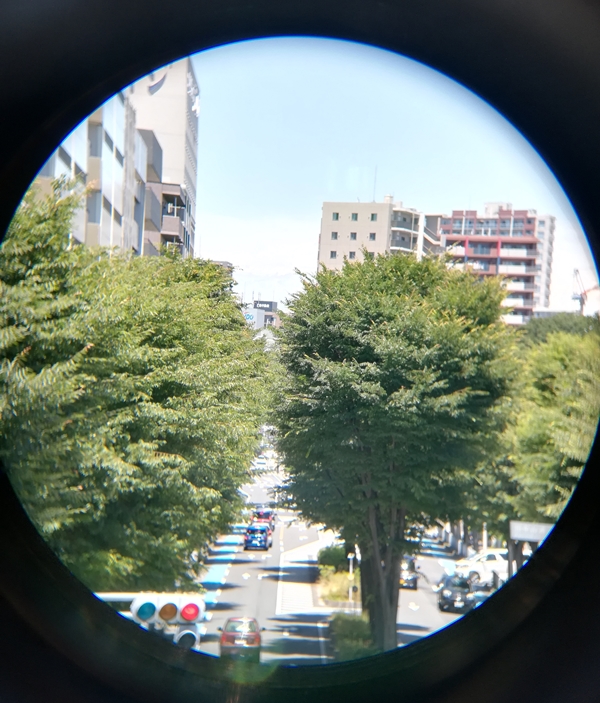No matter how well optics are designed, some aberrations are inevitable. There are no binoculars without aberrations.
One of the most notable aberrations is “chromatic aberration,” which is caused by the differences in light wavelengths. The emergence of lenses made of ED (Extra-low Dispersion) glass has drastically improved the color fringing caused by chromatic aberration.
Besides chromatic aberration, there are five other kinds of aberrations called “Sidel’s Five Aberrations.” So, the image produced by binoculars can be characterized by a combination of these aberrations.

These include pincushion distortion, coma, and astigmatism.
This is a picture taken with the Hinode A5 5×21. The image is clearest in the center of the field, but it gets worse in the peripheral area.
Let’s look at them one by one.
Contents
Sidel’s five aberrations
Astronomers want all stars in the field of view to be seen as pinpoints of light, but manufacturing such a pair of binoculars is almost impossible. Here are the five aberrations known as “Sidel’s Five Aberrations.”
Distortion
This is caused when magnification varies depending on the distance from the optical axis. You’ll notice distortion when you look at a grid pattern through binoculars.
Distortion is more pronounced when looking through wide-angle binoculars, while distortion is rarely an issue with standard angle binoculars.
There are two types of distortion: pincushion distortion and barrel distortion.
If the grid pattern curves outward, this is called barrel distortion. If the grid pattern curves inward, this is called pincushion distortion.

Compared with the vertical red line, the building is slightly curved inwards: pincushion distortion.
When you look through binoculars with barrel distortion and pan in any direction, you can see an optical phenomenon called the “globe effect” or “rolling ball effect,” which can be disorienting and make you nauseous.

Simulated animation of globe effect (right) compared with a simple pan (left) https://en.wikipedia.org/wiki/Globe_effect
Spherical Aberration
The focal point varies depending on how far the light rays are from the optical axis (see below).

Spherical aberration occurs not only in the periphery but also in the center of the field, which affects the overall focus. The larger the diameter of the objective lens, the more spherical aberration.
An aspherical lens reduces spherical aberration, producing a sharper image
Coma
Light coming from the optical axis is focused at different points. Binoculars with coma aberration make stars in the periphery look like comets with their tails pointed outward (see below).

https://logcamera.com/seikei-lenz/
The coma aberration gets worse as the focal distance gets shorter. Coma comes from the Greek word for hair.
Astigmatism
Astigmatism is caused by the difference in radius of the meridional plane and the sagittal plane. When a grid pattern is viewed through binoculars with astigmatism, horizontal lines are in focus while vertical lines are not.

https://logcamera.com/seikei-lenz/
Wide-angle binoculars usually have more astigmatism in the peripheral area.
Field Curvature
The image plane gets curved after coming through a lens. Binoculars with field curvature have the center of the field in focus with the periphery out of focus. On some better binoculars, a field flattener lens is used to correct field curvature.

FUJINON 10×50 FMT-SX https://www.kenko-tokina.co.jp/optics/binoculars/maker/fujinon/4544895001743.html
summary
There are no binoculars without any aberrations. It is simply a matter of degree. Chromatic aberration causes color fringing which can be improved by using ED glass lenses, but there are five other types of aberrations: distortion, spherical aberration, coma, astigmatism, and field curvature.
Generally speaking, the image is best around in the center of the field and it gets worse in the peripheral area. When you use wide-angle binoculars, these aberrations are more noticeable in the peripheral area.
Good quality binoculars are designed to make aberrations less noticeable.
